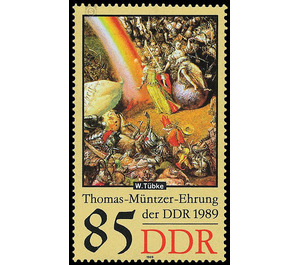Commemorative stamp series - Germany / German Democratic Republic 1989 - 85 Pfennig
Theme: Art & Culture
| Country | Germany / German Democratic Republic |
| Issue Date | 1989 |
| Face Value | 85.00 |
| Color | brown |
| Perforation | K 14 |
| Printing Type | offset |
| Stamp Type | Postage stamp |
| Item Type | Stamp |
| Chronological Issue Number | 3015 |
| Chronological Chapter | GER-DDR |
| SID | 359452 |
| In 15 Wishlists | |
Thomas Müntzer Honoring the GDR On the occasion of the "Thomas Müntzer Honoring of the GDR", the Ministry of Posts and Telecommunications of the German Democratic Republic issued as a second edition five multicolored special postage stamps and a miniature sheet. Special cancellations from August 22 to October 21, 1989 On the occasion of his 500th birthday, the German Democratic Republic honors 1989, resulting from the centuries-long struggle of all progressive forces of the people for social progress, the personality and work of the early bourgeois revolutionary and theologian Thomas Müntzer , At its 24th General Conference, UNESCO highlighted the international nature of this honor. Presumably born in 1489 in Stalberg am Harz, Thomas Müntzer played a historically prominent role in Germany during the Reformation and the Peasants' War from 1517 to 1525/26. In 1506 he was enrolled at the University of Leipzig. In 1512 his name can be found in the register of the University of Frankfurt / Oder. Consecrated in Halberstadt about 1513, between 1514 and 1517 Braunschweig, Halle and Aschersleben are further stations of his work. At the intercession of Martin Luther, who in 1517 had initiated the Reformation movement in the Holy Roman Empire of the German Nation, Thomas Muntzer performed his ministry in 1519 in Jueterbog. From there as a "Lutheran" expelled, Zwickau 1520/21, Prague 1521, Halle-Glaucha, Allstedt and Mühlhausen 15122 to 1525 to the most important sites of his struggle for a reform of church and society. Beyond Martin Luther, Thomas Müntzer, in his sermons and writings, true to his revolutionary understanding of Christian doctrines, advocated a radical transformation of society in the interests of the exploited and enslaved people. His theology of the revolution was aimed at overcoming any class rule, only so could Christian equality and justice on earth be brought about. The wave of revolutionary popular uprisings reached 11524 Mühlhausen and Frankenhausen in Thuringia. On May 15, 1525, the rebels stood at Frankenhausen, the overpowering troops of the feudal rulers to fight. The peasant army was massacred, Thomas Müntzer was taken prisoner, cruelly tortured and executed on the 27th time in Mühlhausen. This sacrificial collection and the revolutionary work of Thomas Müntzer is dedicated to the Peasants' War panorama on the Schlachtberg, Bad Frankenhausen. Here, Werner Tübke (born 1929) created a monumental painting "Early bourgeois revolution in Germany" in the years 1976-19.87 on behalf of the Council of Ministers of the GDR. The enormous round picture (14 m height and 123 m length) is not a history picture in the conventional sense. Rather, this is a highly subjective, metaphorical image interpretation of those social, political, economic, spiritual and religious processes, struggles and transformations that shaped man and society in the epoch of the transition from feudalism to capitalism. The monumental picture by Werner Tübke equates to a festive image staging, impressing him sustainably through his ideological depth, extraordinary professionalism and painterly mastery. 5 motifs were selected for the special postage stamps. The stamp with the nominal value of 5 Pfennig shows the "Annunciation to the peasants" A stern angel announces to the armed peasant a message whose victim-rich consequence scares him: The common man's job is to raise the sword the lords and princes and the Power to fight. This scene finds its meaningful expansion through the transparent sphere, which points to a shattering world view. The brand with the nominal value of 10 Pfennig has the theme of the "life fountain" To a simple Renaissance fountain with lotus flowers and pomegranate, symbol of renewing life, standing personalities, with their life and work the connection of humanism, reformation and peasants war in the early bourgeois Document revolution and count among modern-day obstetricians. the sculptors Velit Stoß and Tietmann Riemenschneider, the painters and graphic artists Jörk Ratgeb, Albrecht Dürer and Lucas Cranach, the reformer Martin Luther, the pioneers of humanism Sebastian Brant, Philipp Melanchthon, Erasmus of Rotterdam and Ulrich von Hutten. For the stamp with the face value of 20 Pfennig was selected as a section "Müntzer in the battle Like a monument, lowered the Bundschuhfahne, stands Thomas Müntzer amidst the still raging but already lost battle.His then clever dream of a classless society lives on and takes In the scene of the "Strebkatz pulling" a popular showdown of two bound opponents, Müntzer wrestled, armed with a Kruzefix, your pope down as his adversary wrestles real figure in the socialist countries On top of this, literally, in the early stages of early capitalism, the ship of the impoverished artisans, "on the dry land." Especially characteristic of the metaphor of Tübkeschen's pictorial inventions is the motif of the stamp with the nominal value of 85 pfennig "Justitia / Fool" The punitive penal judge, Justitia, who has become seen, sits balancing on the globe, the scales of justice lean towards the oppressed peasants, the sword points to the nobility. Among them was the all-seeing fool with the lute, opposite him Pilate, who with the wash of his hand asserted his innocence on the crucifixion of Jesus Christ, but whom he had decided. Equal to Pilate, as the patrician attire indicates, the bourgeoisie also wanted to acquit itself of its share of responsibility for the failure of the early bourgeois revolution in Germany.


